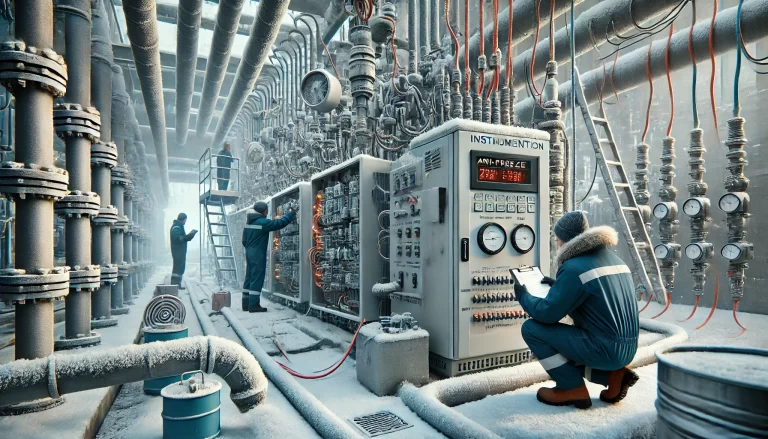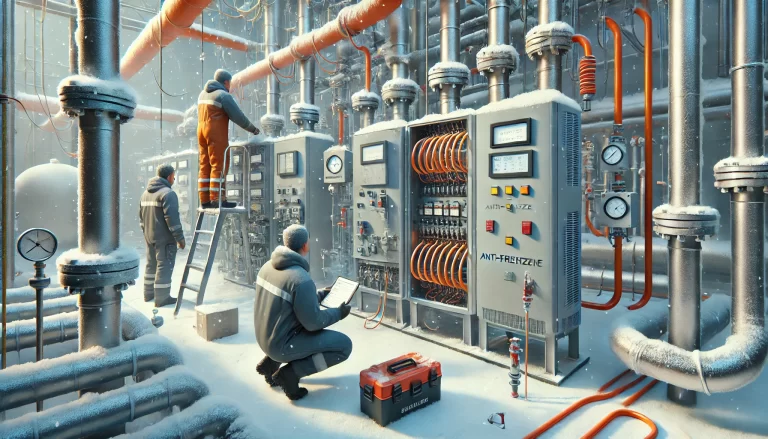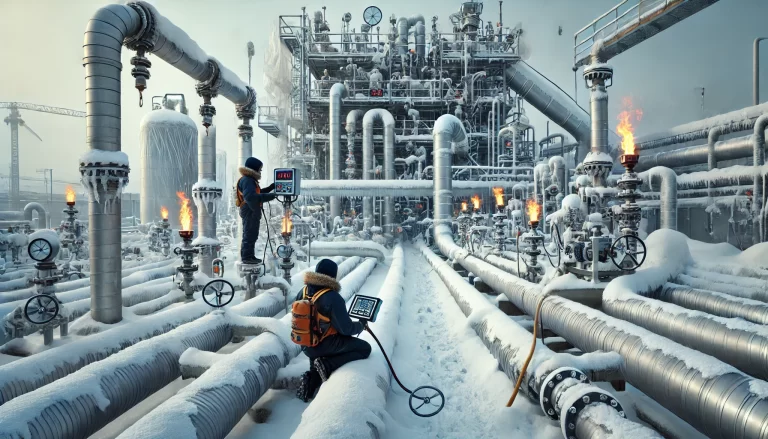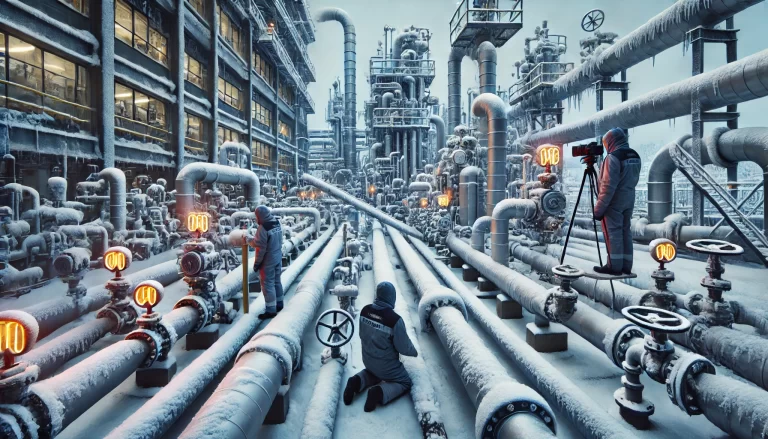As temperatures drop, instrumentation systems face significant challenges, especially from freezing and condensation. Proper inspection standards are crucial to ensure instruments function effectively, maintain measurement accuracy, and avoid malfunctions caused by extreme cold. Below is a comprehensive set of inspection standards for anti-freeze and anti-condensation measures, specifically tailored for instrumentation.
1. Frequency of Inspections
- Seasonal Inspection: Before the onset of winter or any expected cold season, conduct a thorough inspection to ensure all anti-freeze and anti-condensation measures are in place.
- Routine Daily Checks: During cold seasons or in environments with high humidity, increase inspection frequency. This could mean conducting daily checks or inspections per shift to detect issues early.
- Emergency Checks: After sudden temperature drops or when freezing conditions are forecast, additional spot checks on critical instruments may be warranted.

2. Inspection Components
Instrument Cabinets and Housings:
- Check that all instrument enclosures are sealed and intact to prevent cold air from entering. Inspect insulation layers for any signs of damage or wear.
- Ensure that any openings, such as cable inlets or vents, are sealed or fitted with weatherproof materials to prevent frost buildup inside the cabinet.
- Verify that cabinets with heated or insulated interiors are maintaining the correct internal temperature.
Piping and System Equipment:
- Examine all piping associated with instrumentation for insulation coverage. Ensure no insulation materials are missing or damaged, as this could allow freezing.
- Check for potential weak points where condensation might occur, especially at pipe joints, bends, and valves.
- Verify that condensate traps are installed and functioning properly, as frozen condensate can lead to blockages in pipelines.
Heating Systems:
- For systems utilizing heat tracing, confirm that the electric or steam heat tracing systems are working properly.
- Inspect the thermal insulation covering heat tracing elements to confirm it is undamaged and securely affixed.
- Ensure there is adequate insulation on piping or other equipment connected to the heat tracing system.
Sensors and Probes:
- Examine temperature probes, pressure transducers, flow meters, and other sensors for frost or ice buildup.
- For critical outdoor sensors, consider installing anti-freeze sleeves, protective covers, or applying anti-freeze solutions to prevent them from freezing.
- Calibrate sensors to account for cold conditions, as their sensitivity and accuracy may be affected by extreme temperatures.
Drainage and Condensate Removal:
- Ensure all drainage facilities are operational and clear of obstructions to allow condensed water to escape, reducing the risk of freezing inside pipes.
- Regularly empty and inspect condensate pots, as accumulated water can freeze and obstruct measurement lines.
- Implement automated drainage solutions where possible to minimize manual intervention in extreme weather.
Seals and Lubrication:
- Lubricate all moving components to prevent freezing or jamming in cold conditions. Choose low-temperature lubricants that do not thicken in cold.
- Check all seals for wear, particularly around access points like valve stems, to prevent cold air infiltration and potential condensation.
- Verify that all seals meet the manufacturer’s specifications for low-temperature resilience.

3. Heating Systems Inspection
Electric Heat Tracing:
- Inspect electric heat tracing cables for any signs of wear, aging, or damage. Ensure cables are intact, insulated properly, and that power supply connections are secure.
- Test the continuity of heat tracing circuits to confirm they are functioning as expected, and adjust temperature settings if necessary.
- Verify the activation of automatic temperature sensors, which should switch the heat tracing on when ambient temperatures fall below a specified threshold.
Steam Heat Tracing:
- Confirm that steam supply lines are operational and that steam condensate drains are functioning properly, as condensate buildup can lead to frozen sections.
- Inspect joints, valves, and connectors in steam heat tracing systems for potential leaks, which can lead to heat loss and inefficient operation.
- Monitor steam pressures regularly to maintain a consistent heat output, adjusting pressure regulators if necessary.
Temperature Control Devices:
- Check thermostats and other temperature controllers for proper calibration, as they regulate the heating system based on ambient or internal temperatures.
- Ensure that setpoints are correct for seasonal conditions and recalibrate if necessary. Confirm that controllers respond quickly to temperature changes.
4. Focused Inspections on Critical Instruments
Primary Instrumentation Components:
- For high-value or safety-critical instruments, such as pressure transmitters, flow meters, temperature gauges, and level sensors, perform detailed inspections to ensure reliability.
- Conduct functional testing on primary instruments, especially those with exposed components, to confirm they remain unaffected by the cold.
- For any sensitive components particularly vulnerable to freezing, implement enhanced protective measures, including insulated enclosures or additional heat tracing.
Cold-Sensitive Instruments:
- Identify instruments that are more susceptible to low temperatures and assign them a higher inspection priority. Examples include any devices that use liquid-filled sensors or pneumatic instruments with moisture-prone lines.
- Monitor these cold-sensitive instruments frequently and install redundant systems if necessary for critical applications.

5. Emergency Measures and Contingency Plans
Develop Response Plans:
- Establish a response protocol for incidents where freezing or condensation issues are detected, ensuring quick remediation.
- Train personnel on emergency response procedures for frozen pipes or malfunctioning equipment, including rapid thawing methods.
- Maintain a log of issues identified during cold conditions and update procedures as needed.
Prepare Defrost and Anti-Freeze Tools:
- Stock essential defrost equipment and supplies, such as portable heaters, de-icing sprays, and hand tools for removing ice buildup.
- Make sure all personnel are trained to safely use these tools, particularly around sensitive instrumentation.
Employee Training:
- Regularly train staff on anti-freeze and anti-condensation procedures, including preventive and emergency actions.
- Ensure employees understand the operational impact of frozen or malfunctioning instruments, and empower them to report issues promptly.
6. Documentation and Reporting
Daily and Weekly Logs:
- Maintain detailed logs for each inspection, especially noting any abnormalities or corrective actions taken.
- Track recurring issues to identify patterns and adjust inspection routines as needed.
Regular Reporting and Analysis:
- Review and analyze inspection data regularly to assess the effectiveness of anti-freeze and anti-condensation measures.
- Identify trends and areas for improvement, such as recurring frost issues, and take preventive actions to mitigate future occurrences.

Implementing these standards ensures instrumentation remains reliable, even in extreme cold, preventing costly equipment failure and maintaining measurement accuracy. Following this rigorous inspection and maintenance routine provides a foundation for safe, efficient, and uninterrupted operation throughout the winter months.
